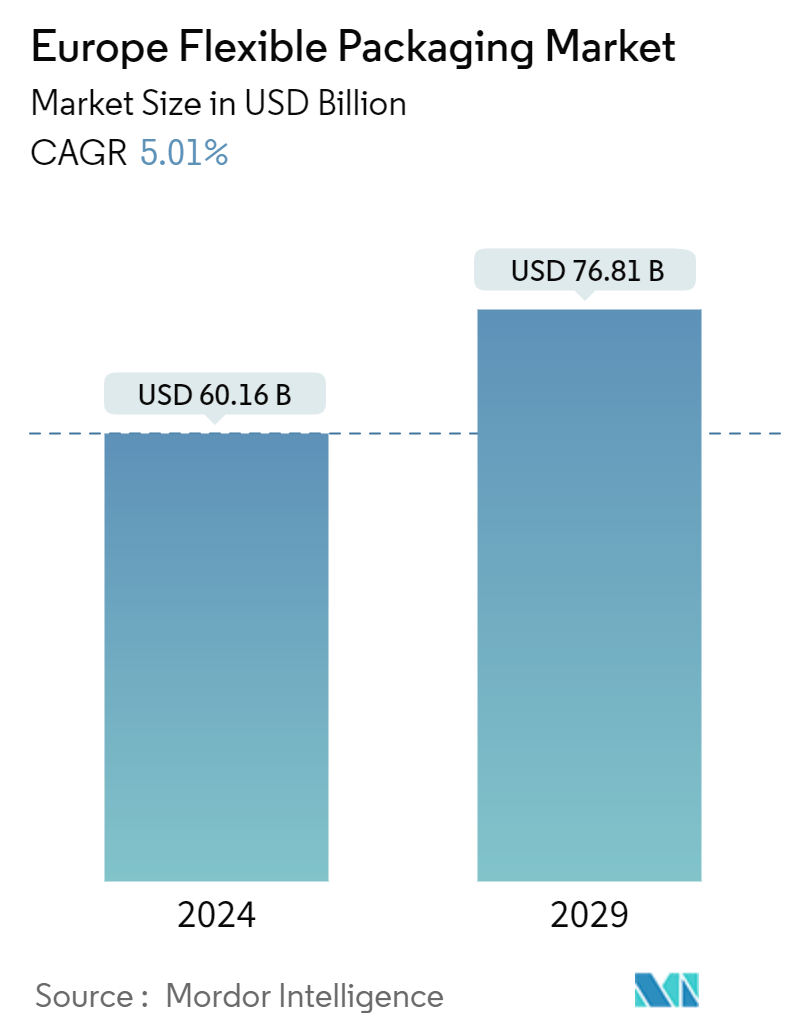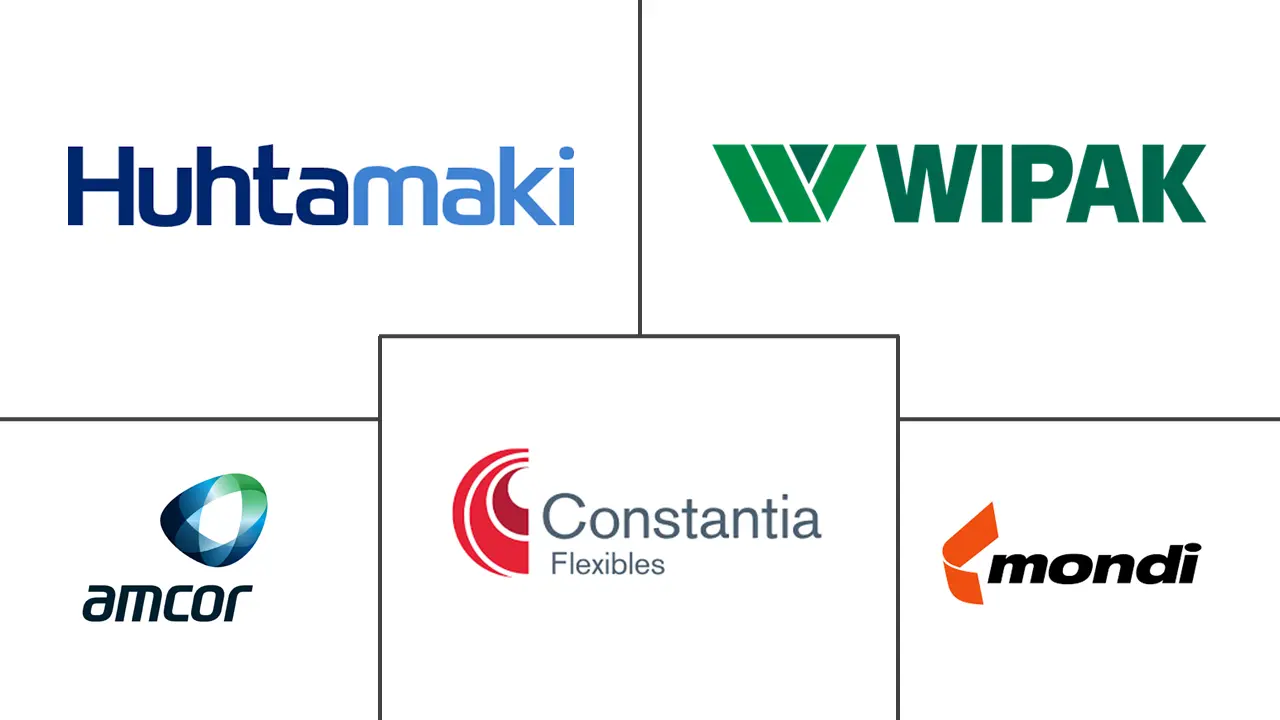
| Study Period | 2019 - 2029 |
| Base Year For Estimation | 2023 |
| Forecast Data Period | 2024 - 2029 |
| Market Size (2024) | USD 60.16 Billion |
| Market Size (2029) | USD 76.81 Billion |
| CAGR (2024 - 2029) | 5.01 % |
| Market Concentration | Low |
Major Players
*Disclaimer: Major Players sorted in no particular order |
Europe Flexible Packaging Market Analysis
The Europe Flexible Packaging Market size is estimated at USD 60.16 billion in 2024, and is expected to reach USD 76.81 billion by 2029, growing at a CAGR of 5.01% during the forecast period (2024-2029).
- Growing demand for processed, conveniently packaged, and pre-prepared foods and snacks in Europe will expand the market. This trend is also fueled by the continent's expanding urban population and shifting lifestyle habits, such as less time spent on meal preparation.
- Furthermore, because flexible packaging solutions can extend the shelf life of such products, the demand for packaged foods, ready-to-eat meals, frozen foods, and luxury foods is anticipated to rise in the nation. The emergence of sustainable, flexible packaging solutions has also been aided by rising consumer desire for product personalization and rising demand from food and beverage industries for recyclable and eco-friendly packaging.
- Owing to the region's fast-changing lifestyles and economic expansion, the preference for processed and packaged goods has driven the market for food packaging. The primary cause of the rising appetite for processed foods is the population's movement from rural to urban locations. However, the amount of plastic packaging waste in the area is rising (by 2% annually). The EU Commission is considering outlawing all plastic packaging, which is predicted to slow market expansion. According to Virginijus Sinkevicius, the incoming EU commissioner for the environment, plastic packaging and the use of recovered plastic would be outlawed.
- The dairy industry is one of many that uses plastic and concentrates on using less plastic. Lord Rooker, the United Kingdom's Food and Farming Minister, has urged the dairy industry to become more sustainable, with a 50% reduction in the number of plastics used in milk packaging. That suggests that greener packaging will continue to expand in a nation that has already demonstrated innovation diversity.
- The expanding cosmetics sector backs the market in France. For their cosmetic items, several well-known brands are choosing flexible packaging materials. Flexible solutions are more affordable and have a longer shelf life than stiff plastic. Consequently, the expanding cosmetics industry is anticipated to open up the lucrative potential for the flexible packaging market.
- The European market may face difficulties due to the financial crisis's effects on consumer spending power, rising commodity prices, and other similar concerns. Modern infrastructure is required for the process of recycling plastic packaging waste. It is a time-consuming operation that demands personnel competence.
- Additionally, due to the widespread usage of plastic material for flexible packaging, specific environmental issues regarding recyclability and sustainability may marginally restrict the market growth. Recycling and disposal rules are becoming stricter in a number of European nations, which could provide a problem for some merchants there. All of these things limit the expansion of the European flexible packaging market.
Europe Flexible Packaging Industry Segmentation
Flexible packaging is a means of packaging products made of non-rigid materials, allowing for more economical and customizable options. Flexible packaging can easily change shape during filling or use. The analysis is based on the market insights captured through secondary and primary research. The market also covers the major factors impacting the growth of the flexible packaging market in terms of drivers and restraints.
The Europe flexible packaging market is segmented by material type (polyethylene (PE), biaxially oriented polypropylene (BOPP). cast polypropylene (CPP), polyvinyl chloride (PVC), PET, and other material types), by product type (pouches, bags, packaging films (PE-based, BOPET, CPP and BOPP, PVC), and other product types), by end-user industry (food (frozen food, dairy products, fruits and vegetables, other food products), beverage, healthcare, and pharmaceuticals, cosmetics and personal care, and other end-user industries), by country (Western Europe (United Kingdom, Germany, France, Italy, Spain, Rest of Western Europe), Eastern and Central Europe (Poland, Czech Republic, Romania, Hungary, Rest of Eastern and Central Europe)). The market sizes and forecasts are provided in terms of value USD for all the above segments.
| Polyethene (PE) |
| Biaxially Oriented Polypropylene (BOPP) |
| Cast Polypropylene (CPP) |
| Polyvinyl Chloride (PVC) |
| PET |
| Other Material Types (EVOH, EVA, PA, etc.) |
| Pouches | |
| Bags | |
| Packaging Films | PE-based |
| BOPET | |
| CPP and BOPP | |
| PVC | |
| Other Film Types | |
| Other Product Types |
| Food | Frozen Food |
| Dairy Products | |
| Fruits and Vegetables | |
| Other Food Products | |
| Beverage | |
| Healthcare and Pharmaceuticals | |
| Cosmetics and Personal Care | |
| Other End-user Industries |
| Western Europe | United Kingdom |
| Germany | |
| France | |
| Italy | |
| Spain | |
| Eastern and Central Europe | Poland |
| Czech Republic | |
| Romania | |
| Hungary |
Europe Flexible Packaging Market Size Summary
The European flexible packaging market is poised for significant growth, driven by the increasing demand for processed, conveniently packaged, and pre-prepared foods. This demand is largely attributed to the continent's expanding urban population and evolving lifestyle habits, which favor quick and easy meal solutions. Flexible packaging solutions are particularly appealing as they extend the shelf life of products, making them ideal for packaged foods, ready-to-eat meals, and frozen foods. The market is also benefiting from a rising consumer preference for sustainable and eco-friendly packaging options, spurred by the food and beverage industries' push for recyclable materials. However, the market faces challenges from the growing plastic packaging waste and potential regulatory actions by the EU Commission to ban plastic packaging, which could hinder growth.
The market landscape is characterized by a semi-consolidated structure, with major players like Amcor PLC, Mondi Group, and Huhtamaki Oyj leading the charge. These companies are actively expanding their market presence through strategic collaborations and innovations in sustainable packaging technologies. The rise of e-commerce and the convenience of online grocery shopping are further propelling the demand for flexible packaging, as consumers increasingly seek the ease of home delivery and the benefits of packaged foods. Despite the challenges posed by environmental concerns and regulatory pressures, the market is expected to continue its upward trajectory, supported by the ongoing development of innovative and environmentally friendly packaging solutions.
Europe Flexible Packaging Market Size - Table of Contents
1. MARKET DYNAMICS
-
1.1 Market Drivers
- 1.1.1 Steady Rise in Demand for Processed Food
- 1.1.2 Move Toward Light Weighting Expected to Spur Volume Demand
-
1.2 Market Restarints
- 1.2.1 Flexible Packaging is Increasingly Turning into a Competitive Marketplace which Could Impact the Growth Prospects of New Entrants
- 1.2.2 Environmental Challenges Related to Recycling
2. MARKET SEGMENTATION
-
2.1 By Material Type
- 2.1.1 Polyethene (PE)
- 2.1.2 Biaxially Oriented Polypropylene (BOPP)
- 2.1.3 Cast Polypropylene (CPP)
- 2.1.4 Polyvinyl Chloride (PVC)
- 2.1.5 PET
- 2.1.6 Other Material Types (EVOH, EVA, PA, etc.)
-
2.2 By Product Type
- 2.2.1 Pouches
- 2.2.2 Bags
- 2.2.3 Packaging Films
- 2.2.3.1 PE-based
- 2.2.3.2 BOPET
- 2.2.3.3 CPP and BOPP
- 2.2.3.4 PVC
- 2.2.3.5 Other Film Types
- 2.2.4 Other Product Types
-
2.3 By End-user Industry
- 2.3.1 Food
- 2.3.1.1 Frozen Food
- 2.3.1.2 Dairy Products
- 2.3.1.3 Fruits and Vegetables
- 2.3.1.4 Other Food Products
- 2.3.2 Beverage
- 2.3.3 Healthcare and Pharmaceuticals
- 2.3.4 Cosmetics and Personal Care
- 2.3.5 Other End-user Industries
-
2.4 By Country
- 2.4.1 Western Europe
- 2.4.1.1 United Kingdom
- 2.4.1.2 Germany
- 2.4.1.3 France
- 2.4.1.4 Italy
- 2.4.1.5 Spain
- 2.4.2 Eastern and Central Europe
- 2.4.2.1 Poland
- 2.4.2.2 Czech Republic
- 2.4.2.3 Romania
- 2.4.2.4 Hungary
Europe Flexible Packaging Market Research Faqs
How big is the Europe Flexible Packaging Market?
The Europe Flexible Packaging Market size is expected to reach USD 63.17 billion in 2025 and grow at a CAGR of 5.01% to reach USD 80.67 billion by 2030.
What is the current Europe Flexible Packaging Market size?
In 2025, the Europe Flexible Packaging Market size is expected to reach USD 63.17 billion.


